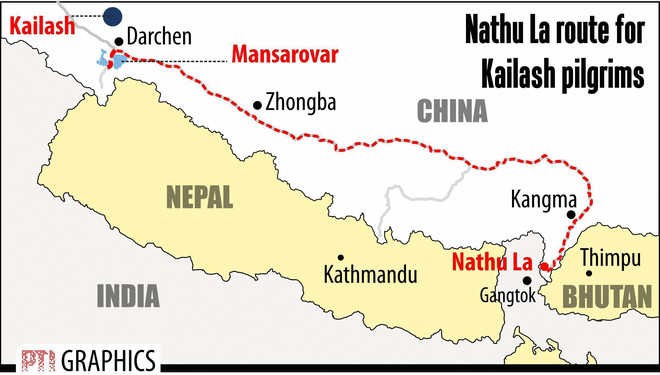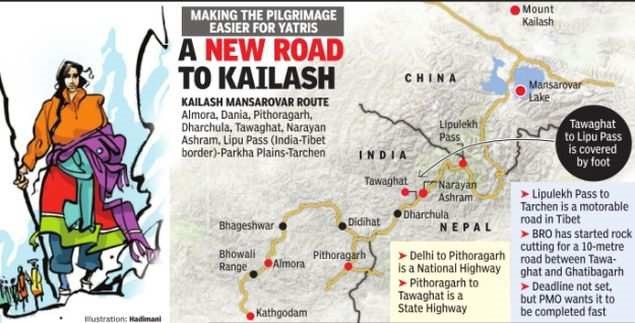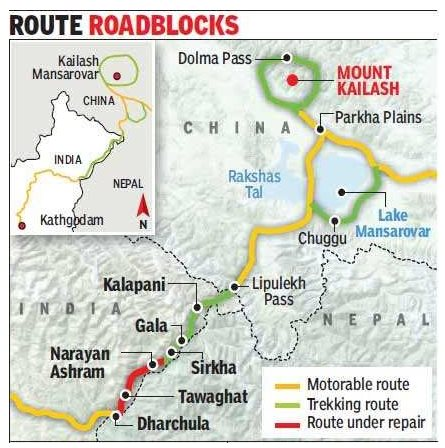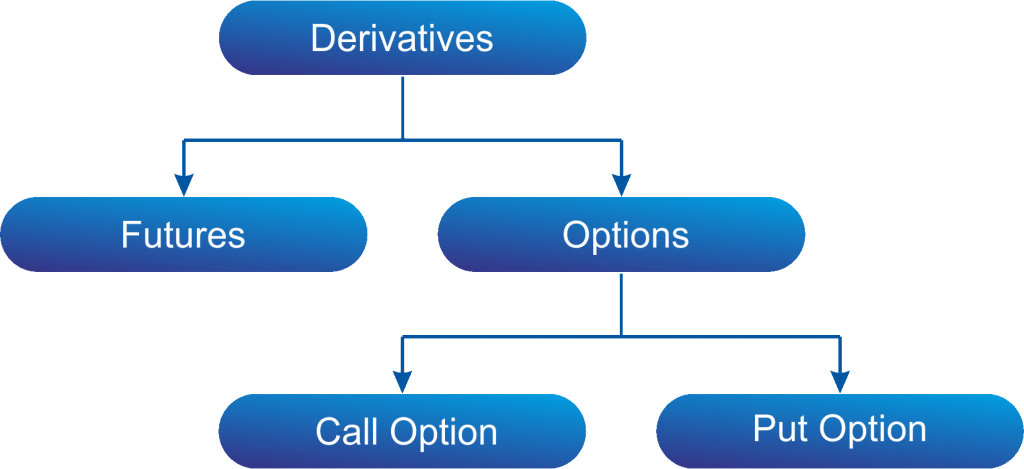Contents:
- Kailash – Mansarovar Yatra Route from Dharchula to Lipulekh (China Border) Completed
- Indian Red Cross Society completed 100 years
- INR – USD Futures and Options contracts in the International Exchanges at GIFT-IFSC
- India & AIIB sign agreement for $500 million COVID-19 support
KAILASH – MANSAROVAR YATRA ROUTE FROM COMPLETED
Focus: GS-I Geography
Why in news?
Border Roads Organisation (BRO) has completed the road connectivity from Dharchula to Lipulekh (China Border) famously known as Kailash-Mansarovar Yatra Route.
Details:
- The Darchula – Lipulekh road is an extension of Pithoragarh-Tawaghat-Ghatiabagarh road.
- It originates from Ghatiabagarh and terminates at Lipulekh Pass, the gateway to Kailash Mansarovar. In this 80 Km road, the altitude rises from 6000 feet to 17,060 feet.
- With the completion of this project, the arduous trek through treacherous high-altitude terrain can now be avoided by the Pilgrims of Kailash MansarovarYatra and the period of journey will be reduced by many days.
- At present, the travel to Kailash Mansarovar takes around two to three weeks through Sikkim or Nepal routes. Lipulekh route had a trek of 90 Km through high altitude terrain and the elderly yartris faced lot of difficulties. Now, this yatra will get completed by vehicles.
Old route of Kailash MansarovarYatra:

New route of Kailash MansarovarYatra:

Background:
- Pilgrims from India can reach Kailash Mansarovar through three routes — via Sikkim, Uttarakhand and Kathmandu in Nepal — all of which are long and arduous.
- The route via Uttarakhand involves three stretches. The first stretch is a 107.6 km-long road from Pithoragarh to Tawaghat, the second is from Tawaghat to Ghatiabgarh on a 19.5-km single lane, and the third stretch is the 80 kms from Ghatiabgarh to Lipulekh Pass at the China border, which can only be traversed on foot. This stretch till the India-China pass takes five days to cover.
- The BRO is converting the second stretch into a double lane road, and is building a new road on the third stretch to allow vehicles. It has so far completed 76 km of the 80-km stretch, cutting travel time to just two days by a vehicle.
- On crossing the International Border into China, pilgrims must walk another 5 km, followed by a road journey of 97 km and the final 43 km-parikrama around Mount Kailash.

Travel to Kailash
- The Kailash-Mansarovar road alignment is along the Kali river, which is the boundary between India and Nepal.
- The end point of road is at Lipulekh Pass, a tri-junction of India, China and Nepal.
- The yatra is organised by the Ministry of External Affairs and the journey beyond the International Border is overseen by Chinese authorities.
Kailash-Mansarovar:
- Kailash Manasarovar, the Hindu holy site located in Tibet. Every year, the Indian pilgrims have a visit to this holy site.
- Kailash Manasarovar, a pilgrimage for the followers of four religions, is the toughest pilgrimage in the world.
- Situated some 20 km from the Mt Kailash, the lake Manasarovar further holds a prime significance in the mythology.
- This region sees an inception of four of the prime rivers namely Sutlej, Indus, Brahmaputra and Karnati.
- Kailash Mansarovar Yatra is known for its cultural significance, religious value, physical beauty and thrilling nature.
- Holding importance for the Hindus as the abode of Lord Shiva, it embraces religious importance also for the Buddhists and the Jains.
- The Kailash Manasarovar Yatra is arranged by the Government of India, Ministry of External Affairs beginning early May/early June to September.
About the Manasarovar lake
- It is located near the foot of the Mount Kailash and its waters are replenished by the Kailash Glaciers in the Tibet Autonomous Region, China.
- Lake Manasarovar lies at an elevation of 4590 m above the mean sea level. This is relatively unknown for a freshwater lake, though higher and larger saline water lakes exist in the Tibetan Plateau.
- The Kailash Mansarovar lake holds a highly revered sacred place in four religions (Bon, Buddhism, Hinduism, and Jainism) and is the site of an annual pilgrimage undertaken by Indian citizens known as the Kailash Mansarovar Yatra.
- The Mansarovar Lake, along with its nearby saline counterpart, the Rakshas-Tal lake were parts of the Sutlej Basin in the past but are now separated due to tectonic activity.
INDIAN RED CROSS SOCIETY COMPLETED 100 YEARS
Focus: GS-II Social Justice
Why in news?
Indian Red Cross Society completed 100 years of existence.
Indian Red Cross Society:
- Established in 1920 under the Indian Red Cross Society Act and incorporated under Parliament Act XV of 1920.
- President of India is designated the President of the Indian Red Cross Society and Union Health Minister is the Chairman of the Society.
- The Indian Red Cross Society (IRCS) is a voluntary humanitarian organization to protect human life and health based in India.
- It is part of the International Red Cross and Red Crescent Movement, and so shares the Fundamental Principles of the International Red Cross and Red Crescent Movement.
- The society’s mission is providing relief in times of disasters/emergencies and promoting health & care of vulnerable people and communities.
- It has a network of over 700 branches throughout India. The Society uses the Red Cross as an emblem in common with other international Red Cross societies.
International Federation of Red Cross and Red Crescent Societies:
- The International Federation of Red Cross and Red Crescent Societies (IFRC) is a global humanitarian organization, which coordinates and directs international assistance following natural and man-made disasters in non-conflict situations.
- It was founded in 1919 in Paris in the aftermath of World War I.
- It is headquartered in Geneva, Switzerland.
- It is the world’s largest humanitarian network which is guided by seven Fundamental Principles: Humanity, impartiality, neutrality, independence, voluntary service, universality and unity.
INR – USD FUTURES AND OPTIONS CONTRACTS
Focus: GS-III Indian Economy
Why in news?
Union Minister for Finance & Corporate Affairs launched INR-USD Futures and Options contracts on the two International Exchanges, viz BSE’s India INX and NSE’s NSE-IFSC, at GIFT International Financial Services Centre at Gandhinagar.
Background:


What are futures?
- Futures are contracts made between two parties wherein they agree to buy or sell a particular asset at a fixed price at a particular time in the future. This helps in reducing the risk and losses involved.
- Let’s say you are a soybean farmer, there is good rainfall and hence the supply of soybean is high and so the prices come down. You will be at loss as a farmer.
- Think of the soybean buyer now. Due to unexpected drought, the price of soybean goes up.
- So, as a buyer, he has to shell out more and hence he faces loss.
- To avoid these losses, it is essential to enter into futures contract. This will protect you irrespective of the market fluctuations.
- For example, the price of soybean hits Rs. 350 after 3 months, but if you have already made a futures contract at Rs. 400, you will gain a profit of Rs. 50 even though the market price is Rs. 350.
- By this way, you can predict the future demand, price and also reduce the losses. You can actually trade using lesser margins in case of futures contract
What are options?
Option contract gives buyer the right, but he is under no obligation to buy or sell the asset. Whereas the seller of the options contract is under obligation to buy or sell the asset based on the option contract buyer’s decision. For example, you have a bike and purchased insurance for the bike at Rs. 10000. If your bike is damaged, you will get your insurance claim as per the agreement. But if no such damage happens, the premium you paid becomes the income for the insurance company. In case of option buyer, the return potential is unlimited whereas risk or loss is limited to premium only. In case of option seller, return is limited to the premium whereas the risk involved is unlimited. There are 2 types of options namely call option and put option
1. Call option
In this case, the owner has the right but has no obligation to buy the asset. For example, you made a call option contract with say Kumar for buying TCS share at Rs. 500. The price of TCS in the market is Rs. 600. So you will definitely prefer to buy share from Kumar at Rs. 500 rather than paying Rs. 100 more. Your profit is Rs. 100 in this case. If the price of the share is Rs.400 in the market, you would prefer to buy it from the market rather than buying it from Kumar. So, what profit does Kumar get here? When you enter into a contract, you are required to pay a premium. So even if you don’t buy the shares from Kumar, he is benefitted due to the premium you have paid earlier.
2. Put option:
Put option buyer has the right to sell but has no obligation to sell the contract and put option seller has the obligation to buy. In this case too, the buyer of the contract pays premium. Profit is unlimited in case of contract buyer whereas it is limited in case of contract seller
What is GIFT-IFSC?
- An IFSC enables bringing back to India the financial services and transactions that are currently carried out in offshore financial centers by Indian corporate entities and overseas branches / subsidiaries of financial institutions (FIs) by offering business and regulatory environment that is comparable to other leading international financial centers in the world like London and Singapore.
- It would provide Indian corporates easier access to global financial markets. IFSC would also compliment and promote further development of financial markets in India.
- The first IFSC in India has been set up at GIFT (Gujarat International Finance Tec-City) City, Gandhinagar, Gujarat.
What is GIFT city?
- It is a Central Business District being built between Ahmedabad and Gandhinagar in Gujarat
- Its main purpose is to provide high quality physical infrastructure(electricity, water, gas, district cooling, roads, telecoms and broadband), so that finance and tech firms can relocate their operations in it
- It will have a SEZ, international education zone, integrated townships, an entertainment zone, hotels, a convention centre, and international techno park, Software Technology Parks of India (STPI) units, shopping malls, stock exchanges etc.
- Gujarat International Finance Tec-City Company Limited (GIFTCL) is responsible for developing and implementing the project. GIFTCL is a joint venture of Gujarat Urban Development Company Limited (GUDCOL) and Infrastructure Leasing & Financial Services (IL&FS)
INDIA & AIIB SIGN AGREEMENT FOR COVID-19 SUPPORT
Focus: GS-II International Relations
Why in news?
The Government of India and the Asian Infrastructure Investment Bank (AIIB) signed a US$ 500 million “COVID-19 Emergency Response and Health Systems Preparedness Project”.
Details:
- This new support will cover all States and Union Territories across India and address the needs of infected people, at-risk populations, medical and emergency personnel and service providers, medical and testing facilities, and national and animal health agencies.
- The project will also enhance the resilience of India’s health system to provide core public health prevention and patient care to better manage COVID-19 and future disease outbreaks.
- It will help strengthen India’s Integrated Disease Surveillance Program, revamp infectious disease hospitals, district, civil, general and medical college hospitals, and build a network of high containment Biosafety Level 3 laboratories.
- The project is being financed by the World Bank and AIIB in the amount of $1.5 billion, of which $1.0 billion will be provided by World Bank and $500 million will be provided by AIIB.
About Asian Infrastructure Investment Bank:
The Asian Infrastructure Investment Bank (AIIB) is an international financial institution proposed by China. The purpose of the multilateral development bank is to provide finance to infrastructure projects in the Asia-Pacific region.
It is headquartered in Beijing.
- It commenced operations in January 2016.
- By investing in sustainable infrastructure and other productive sectors today, it aims to connect people, services and markets that over time will impact the lives of billions and build a better future.
Membership:
- Membership in the AIIB is open to all members of the World Bank or the Asian Development Bank and is divided into regional and non-regional members.
- Regional members are those located within areas classified as Asia and Oceania by the United Nations.
- Unlike other MDBs (multilateral development bank), the AIIB allows for non-sovereign entities to apply for AIIB membership, assuming their home country is a member.
- Thus, sovereign wealth funds (such as the China Investment Corporation) or state-owned enterprises of member countries could potentially join the Bank.
- The China-led Asian Infrastructure Investment Bank (AIIB) has officially approved 57 nations as prospective founding members, with Sweden, Israel, South Africa, Azerbaijan, Iceland, Portugal and Poland the latest to be included.
- Countries accepted as AIIB founding members include China, India, Malaysia, Indonesia, Singapore, Saudi Arabia, Brunei, Myanmar, the Philippines, Pakistan, Britain, Australia, Brazil, France, Germany and Spain.
- Founding members have priority over nations that sign up later because they will have the right to set the rules for the bank.
- As of May, 2020, the bank currently has 78 members as well as 24 prospective members from around the world.
Financial Capital of AIIB:
- The AIIB’s initial total capital is USD 100 billion divided into 1 million shares of 100 000 dollars each, with 20% paid-in and 80% callable.
- Paid-Up Share Capital: It is the amount of money that has already been paid by investors in exchange for shares of stock.
- Called-Up Share Capital: Some companies may issue shares to investors with the understanding they will be paid at a later date.
- This allows for more flexible investment terms and may entice investors to contribute more share capital than if they had to provide funds up front.
- China is the largest contributor to the Bank, contributing USD 50 billion, half of the initial subscribed capital.
- India is the second-largest shareholder, contributing USD 8.4 billion.
- Voting Rights:
- China is the largest shareholder with 26.61 % voting shares in the bank followed by India (7.6%), Russia (6.01%) and Germany (4.2 %).
- The regional members hold 75% of the total voting power in the Bank.





